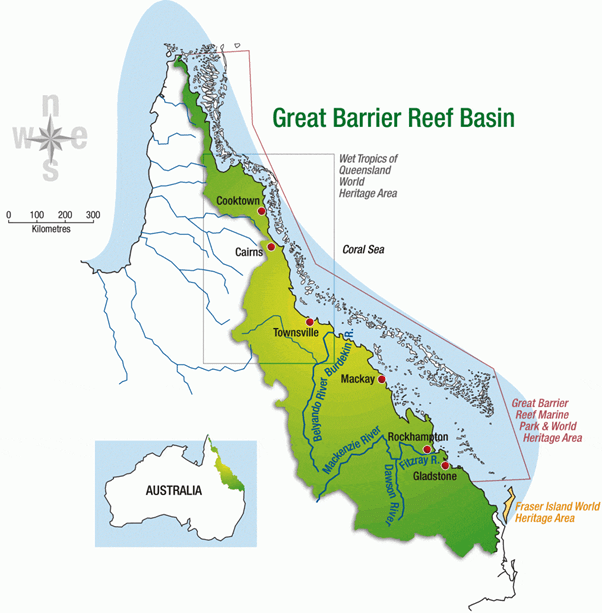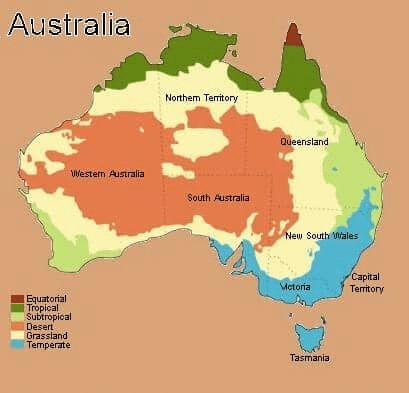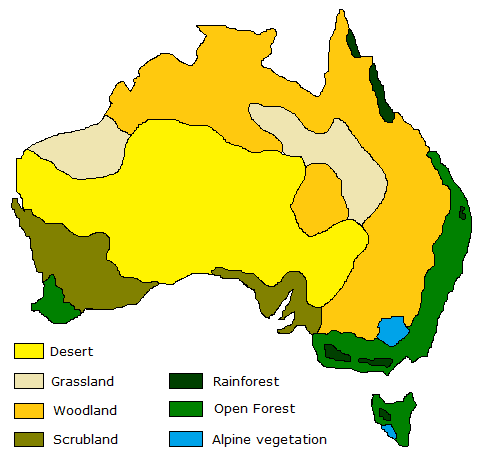UPSC Exam > UPSC Notes > Geography for UPSC CSE > Australia and Oceania
Australia and Oceania | Geography for UPSC CSE PDF Download
| Table of contents |

|
| Australia and Oceania |

|
| Australia |

|
| Major states |

|
| The Islands of Australia & Oceania |

|
| Drainage System |

|
| Climatic zones |

|
| Natural Vegetation |

|
| New Zealand |

|
Australia and Oceania
- Thousands of islands combine to form the Oceania region mostly covering the Central and South Pacific Ocean.

- The region is dominated by the world’s biggest island and two other major landmasses, the micro-continent of Zealandia ( includes New Zealand) and the western half of the island of New Guinea, made up of the nation of Papua New Guinea. Oceania also includes three island regions: Melanesia, Micronesia, and Polynesia (including the U.S. state of Hawaii).

- It stretches from the Strait of Malacca to the coast of the Americas.
- The Tropic of Capricorn divides it into almost two halves.
- Australia is the world’s largest island and smallest continent.
- It is the only nation that completely covers a continent.
- Its total area is nearly double that of India and Pakistan combined.
- It lies entirely in the Southern Hemisphere and is aptly named – Austral meaning south.
- It is located between the Indian and Pacific Oceans, stretches west to east from 114°E longitude to 154°E longitude and from 10°S to 40°S latitude.
- The Tropic of Capricorn cuts the continent almost in half. Asia is the continent nearest to Australia.
- The nearest point on the mainland of Asia is Singapore To the west of Australia, the Indian Ocean, to the south, the icy shore of Antarctica to the south-east is New Zealand.
- To the northwest is the continent of Asia.

Australia
➤ Capital: Canberra
- It is the only continent that is also a country
- It lies between the Indian and the Pacific oceans
- It is surrounded by
- The Timor Sea in the North-West
- The Gulf of Carpentaria in the North,
- Great barrier reef in the north-east &
- Great Australian bight in the south
- To the southeast of the mainland lies the island of Tasmania

Major states
It has 6 states and 2 centrally administered territories.
Its 6 states are:
1. Western Australia
2. Queensland
3. South Australia
4. New South Wales
5. Victoria
6. Tasmania
- Australia is the most leveled and lowest of all the continents.
- There are no high mountains, deep valleys, or large rivers.
- Mount Kosciusko 2,230 meters above sea level, is the highest peak.
- The coastline is very smooth with no inlets except in the south. So there are very few good harbors.
- As the smallest continent, Australia has no prominent physical division, yet efforts have been made to divide it roughly into four categories, such as:
Physical Divisions
- Eastern Highland
- The Western Plateau
- Desert
- The Central Lowland
- The Great Barrier Reef
 ➤ Eastern Highland
➤ Eastern Highland
- This is a chain of hills and mountains which interrupts the leveled landform of Australia.
- These are also known as the Great Dividing Range.
➤ The Great Dividing Range
- It is, also known as the Eastern Highlands, is Australia’s most substantial mountain range.
- The range stretches more than 3500 km from the northeastern tip of Queen’s land, running the entire length of the eastern coastline through New South Wales, then into Victoria and turning water, before finally fading into the central plain at the Grampians in western Victoria.
- The Great Dividing Range does not consist of a single mountain range.
- It consists of a complex of mountain ranges, plateau, upland areas, and escarpments with an ancient and complex geological history.
- The crest of the range is defined by the watershed or boundary between the drainage basins of rivers that drain directly eastward into the Pacific Ocean, and those rivers which drain into the Murray- Darling River system towards the west.
- In the north, the rivers on the west side of the range drain towards the Gulf of Carpentaria.
➤ The Western Plateau
- This eroded plateau has undergone the process of erosion for a quite long period. It is characterized by several ‘sinkhole’ a network of underground caves which filled with water.
- The Western Plateau is also called the home for several deserts and the climate is comparatively dry owing to the cold water current of western Australia. The series of the desert in this region are:
- The ranges were originally home to Australian Aboriginal tribes such as the Kulin.
➤ Desert
- Gibson Desert – a central Australian desert
- Great Sandy Desert – a northwestern Australian desert
- Great Victoria Desert – the sixth-largest desert in the world by area, located in south-central Australia.
- Simpson Desert – a central Australian desert
- Little Sandy Desert – a western Australian desert
- Strzelecki Desert – a south-central Australian desert
- Tanami Desert – a northern Australian desert
- Western Desert – a desert located in western Australia, comprising the Gibson, Great Sandy, and Little Sandy deserts.
- Rangipo Desert – a barren light altitude desert on the North Island Volcanic Plateau in New Zealand.
➤ The Central Lowland
- The extensive patch of plain or low land has its existence between the Eastern Highlands and Western Plateau.
- The patch is drained by two rivers such as Murray and Darling which also facilitate the land with irrigation facilities for farming and other essential activities.
- The area is also known as the Great Artesian Basin as it is covered by a number of underground pressurized wells from which the water comes out automatically to the surface. Yet they are not suitable for drinking as they are salty by nature.
➤ The Great Barrier Reef
- This is the largest coral reef in the world.
- It lies along the east coast of Queensland, Australia, in the Pacific Ocean.
- It is about 2,000 kilometers long, in some places, it is as close as 16 kilometers to the coast while in other places it is 200 kilometers away.
- It is one of the natural wonders of the world.
- It is formed by the tiny coral polyps.

The Islands of Australia & Oceania

- The islands situated surrounding the younger most continent in size are collectively known as Oceania. Broadly it has been divided into three major island groups Melanesia, Micronesia, and Polynesia.
- Melanesia is otherwise known as Black Islands and congregated around the north and east of Australia. Some of the major islands are East Timor, Fiji, New Caledonia, Papua New Guinea, Solomon Islands, and Vanuatu.
- Micronesia which is also called as Little Islands is the agglomeration of islands such as Guam, Kiribati, Marshall Islands, Federated States of Micronesia, Nauru, Northern Mariana Islands, Palau, and Wake Island.
- Polynesia is otherwise known as Many Lands which expand from the islands of Midway in the north to New Zealand in the south and include a series of islands such as the American Samoa Cook Islands, French Polynesia, Niue, Pitcairn, Tokelau, Tonga, Tuvalu, Wallis and Futuna Islands.
- The islands of Oceania have been formed due to the differential activities of volcanoes.
- The low islands of Micronesia have been formed by building up coral reefs on the rim of the volcanic islands, hence giving it a shape of a Ring which is known as Atolls.
- The atolls further encircle the lagoons which are characterized by shallow pools of clear water at a very low altitude of just a few feet above sea level.

Drainage System
- Australia has low average rainfall.
- Being a hot dry country the rate of evaporation is high. So there is very little water left to flow like a river to the sea.
- As a result of this, the total Australian continent is mainly drained by two of the largest drainage basins Murray and Darling and an inland lake is also found which is known as Lake Eyre Basin. Which accounts for an area for over 1 million square kilometers.
- River Murray starts from the Snowy Mountains of the Great Dividing Range.
- Its tributaries are the Darling, Murrumbidgee, and Lachlan. Many dams have been built across these to provide for irrigation and power generation.
- River Swan near Perth is also utilized in the same way.


Climatic zones
- There are generally four types of wind that prevail over the Australian continent throughout the year which affect the climate of the little continent to a large extent.

Seasonal change in the Temperate Zones
The coastal hinterland of New South Wales, much of Victoria, Tasmania, the south-eastern corner of South Australia, and the southwest of Western Australia is contributing the temperate zones where the seasonal changes are as follows –
- Summer: December to February
- Autumn: March to May
- Winter: June to August
- Spring: September to November
- The two similarly affected areas to that of temperate zones are:
- The temperate grassland that surrounds the arid and semiarid desert areas in the center and gradually percolates into the area north of Alice Springs in the Northern Territory.
- Desserts are the arid and semi-arid areas of the center of the continent which stretch across the vast amount of South Australia and Western Australia.
Seasonal change in the Tropical Zones
- There are three climatic zones in the tropical areas of Australia:
- Equatorial – the tip of Cape York and Bathurst and Melville Islands north of Darwin.
- Tropical – across northern Australia including Cape York, the Top End of the Northern Territory, land south of the Gulf of Carpentaria, and the Kimberley region.
- Sub-tropical – the coastal and inland fringe from Cairns along the Queensland coast and hinterland to the northern areas of New South Wales and the coastal fringe north of Perth to Geraldton in Western Australia.
- These above-mentioned areas experience two exactly opposite spells of season i.e. wet and dry seasons.
- The wet season is otherwise called as the monsoon season, which lasts about six months, between November and March. The temperature ranges between 30 and 50 degrees Celsius and comparatively it is hotter than the dry season because of the high humidity during the wet, which is caused by large amounts of water in the air. It is also marked by heavy rainfall which leads to frequent flooding. The dry season lasts about six months, usually between April and October. Temperatures are lower and the skies are generally clearer during the dry. The average temperature is around 20 degrees Celsius.
Natural Vegetation

Downs
- The temperate grassland of Australia known as downs is found in the Murray-Darling basins of the South-Eastern part.
- They are largely used for pastoral activity.
- Cultivation is profitably done in the down areas where Mitchel grasses grown.
- The Mitchel grasses grow even on the cracking clay soils, basaltic soils, and even on skeletal soils.
- Similarly, Canterbury grassland is found in New Zealand.
The Tropical Rain Forest Regions
- These are home to dense forests with coconut palms and mangroves growing nearer the shorelines.
- High temperatures throughout the year with very little rainfall.
The deciduous forest region
- It has a wealth of plant life and includes tall and short trees, shrubs, small plants, and mosses.
- Four distinct seasons with warm summers and cold, wet winters. The trees shed their leaves in autumn.
Savanna
- Very high temperatures all year and rain during the summer season only.
- The dry desert and desert scrub region.
- It is home to the eucalyptus as well as those plants that can survive arid conditions like cacti. Warm to high temperatures with very little rainfall. Hot summers and cold winters with above-average rainfall.
- The varying climate of Australia is largely dependent on its size. The temperature ranges below zero in the Snowy Mountains in southern Australia to extreme heat in the Kimberley region in the northwest of the continent.
- Different climatic zones are characterized by distinct climatic phenomena with prominent seasonal changes.
- Four prominent seasons such as Summer, Autumn, Winter, and Spring are experienced in the Temperate zone, Desert, and the Grassland climatic zones but drastically it has changed to wet and dry seasons in the tropical north of the continent which includes the Equatorial, Tropical and sub-tropical zones.
New Zealand

Important regions of New Zealand
- Taranaki Plain
- Canterbury Plain

➤ Taranaki Plain of New Zealand
- Volcanic plain
- Volcanic peak – Mt. Taranaki
- More than 50% of the region has rich pastureland
- Sheep and cattle rearing for Dairying, meat imp activities
 Taranaki Plain
Taranaki Plain
➤ Canterbury Plain of New Zealand
- Pastoral farming
- Predominantly sheep farming for lamb-wool
- Then cattle rearing for meat then dairying

The document Australia and Oceania | Geography for UPSC CSE is a part of the UPSC Course Geography for UPSC CSE.
All you need of UPSC at this link: UPSC
|
269 videos|870 docs|231 tests
|
FAQs on Australia and Oceania - Geography for UPSC CSE
| 1. What are the major states in Australia? |  |
Ans. The major states in Australia are New South Wales, Queensland, South Australia, Tasmania, Victoria, and Western Australia.
| 2. What is the drainage system like in Australia and Oceania? |  |
Ans. Australia has a complex drainage system with various rivers and basins. The Murray-Darling Basin is the largest river system in Australia, while the Lake Eyre Basin is the largest inland drainage system. Oceania, on the other hand, has numerous small rivers and lagoons due to its island nature.
| 3. How many climatic zones are there in Australia and Oceania? |  |
Ans. Australia and Oceania have a diverse range of climatic zones. Australia is known for its arid and semi-arid regions, as well as temperate and tropical climates. Oceania, encompassing various island nations, experiences a mix of tropical, subtropical, and equatorial climates.
| 4. What types of natural vegetation can be found in Australia and Oceania? |  |
Ans. Australia's natural vegetation varies from tropical rainforests in the northeast, eucalyptus forests in the southeast, and shrublands in the arid interior. Oceania is characterized by a rich variety of vegetation, including tropical rainforests, mangroves, grasslands, and alpine vegetation in higher elevations.
| 5. Is New Zealand part of Australia or Oceania? |  |
Ans. New Zealand is a separate country located in the southwestern Pacific Ocean. While geographically close to Australia, it is not part of the Australian continent. New Zealand is considered part of the Oceania region, along with other Pacific island nations.
Related Searches





















